World Journal of Nuclear Science and Technology
Vol.1 No.2(2011), Article ID:6361,6 pages DOI:10.4236/wjnst.2011.12006
Comparison of Radionuclide’s Inventories and Activities with Slightly Enriched Uranium and Plutonium Fuel in CANDU Reactors
1Physics Division, Islamabad, Pakistan
2Pakistan Institute of Engineering and Applied Sciences, Islamabad, Pakistan
E-mail: yasinzf@yahoo.com, zyasin@cern.ch
Received March 22, 2011; revised May 3, 2011; accepted June 9, 2011
Keywords: Actinide and Fission Product Inventory, CANDU, Natural Uranium, Plutonium
Abstract
In these studies the isotopic inventories and corresponding activities of important nuclides for different fuel cycles of a CANDU reactor have been compared. The calculations have been performed using the computer code WIMSD4. The isotopic inventories and activities have been calculated versus the fuel burn-up for the natural UO2 fuel, 1.2% enriched UO2 fuel and for the 0.45% PuO2-UO2 fuel. It is found that 1.2% enriched uranium fuel has the lowest activity as compared to other two fuel cycles and vice versa for the 0.45% PuO2-UO2 fuel.
1. Introduction
Due to many factors there is again an increase in trend to increase the contribution of nuclear energy, particularly in Asian countries [1,2], in the total world energy demand. The main drawback of nuclear energy is the radioactive waste, particularly spent nuclear fuel, and proliferation issue [2]. Management and handling of spent nuclear fuel and high level radioactive waste from nuclear reactors is a serious problem both from economical and environmental point of view. Shielding design for spent nuclear fuel, its transportation and storage, etc. depend on the activities of the nuclides present in the spent fuel, and these depend on the production of these nuclides during the fuel burn-up process. The more the concentration of these nuclides in the reactor core, the more decay heat these nuclei will produce in the spent fuel and more labours will be required to manage the spent fuel. Secondly, a large amount of plutonium is produced in the spent nuclear fuel, which can be easily separated from the fuel and can be used for military purpose. To overcome these two major concerns with the use of nuclear energy there are two options under consideration. Firstly, to change the composition of nuclear fuel that leads to higher burn-up, less production of plutonium and other minor actinides during burn-up and hence less amount of these nuclides in the spent fuel. Secondly, to entirely change the design of nuclear power reactors, like accelerator-driven systems (ADS) [2,3].
In the present work, we are using the above said first option i.e. changing the fuel composition that leads to higher burn-up and less production of plutonium [1] and minor actinides. We are extending our previous study [1] and calculate the radioactive inventories and activities of important radionuclides during the reactor operation for the same three fuel cycles i.e. natural UO2 fuel, 1.2% enriched UO2 and 0.45% PuO2-UO2 fuel. The above three fuel cycles are considered because these are recently used to study the burn-up extension and proliferation resistance potential with slightly enriched uranium and plutonium in CANDU reactors [1]. The use of slightly enriched uranium would reduce the quantity of spent fuel produced in CANDU reactors and have less environmental impact, compared to other fuel cycles.
Moreover, the above three fuel cycles are selected as the problem of spent fuel can be partially handled by increasing the fuel burn-up and it would reveal positive impact on the spent fuel characteristics [4], volume and decay heat per unit energy produced, and improve the environmental impact. It has been shown that with an increase of the burn-up upto 100 percent may reduce the plutonium production upto 35% [4]. A 1.2% enriched UO2 would increase the burn-up in CANDU by a factor of 3 and hence results in a smaller quantity of spent fuel production [5]. In our present study, with 1.2% enriched UO2 an increase in burn-up is observed by a factor of two [1]. Enrichment would also alleviate pressure on interim storage requirements at the reactor. With enrichment around 1.2%, fuel cycle costs are lowered as compared to natural uranium fuel. Both front end and back end fuel cycle costs would be reduced. It has also been shown that with an enrichment between 0.9% to 1.2% , there would be about 20% reduction in the total disposal cost as compared to natural UO2 [6] and 25% in reduction of uranium requirements can be achieved for enrichment between 0.9% to 1.2%. Furthermore, plutonium recycling in the fuel, mixed with natural or depleted uranium, results in significant improvement in natural uranium utilization and proliferation resistance characteristics [7].
There are different possibilities under consideration to increase the fuel burn-up and reduction of radioactive waste. These include the use of PWRs spent fuel in CANDU reactors [8], use of slightly enriched uranium in CANDU reactors, use of small amount of Plutonium mixed with UO2 or mixed with UO2-ThO2, and Th-233U fuel cycle [9-11].
The purpose of the present work is to calculate and compare the effect of slightly enriched uranium i.e. 1.2% enriched UO2 and 0.45% plutonium mixed (80% 239U, 10% 240Pu and 10% 241Pu) with UO2 on the activities of important isotopes during the fuel burn-up. The analysis is carried out using the computer code WIMSD4 (Winfrith Improved Multigroup Scheme version-D4) [12] for the CANDU 600 MWe PHWR.
2. Reactor Description
There are 380 fuel channels in the standard CANDU 600 MWe reactor and each fuel channel contains 37-fuel pins. Figure 1 of [13] shows a cross sectional view of a fuel channels indicating a fuel bundle, a pressure tube, a calandria tube, and moderator. The coolant and moderator is D2O. The heat is generated in the pressure tubes in the fuel bundle region and coolant transfers this heat to the power conversion system. A gemoterical representation of the cell and lattice benchmark cell model for WIMSD4 is shown in Figures 2 and 3, respectively, of [13]. The reactor data used to model the unit cell is given in Table 1 of [13]. The values of the radial and axial buckling are 4.1925E−5 and 2.6870E−5, respectively.
3. Methodology
The WIMSD4 (Winfrith Improved Multigroup Scheme version-D4) code is used to calculate the concentrations
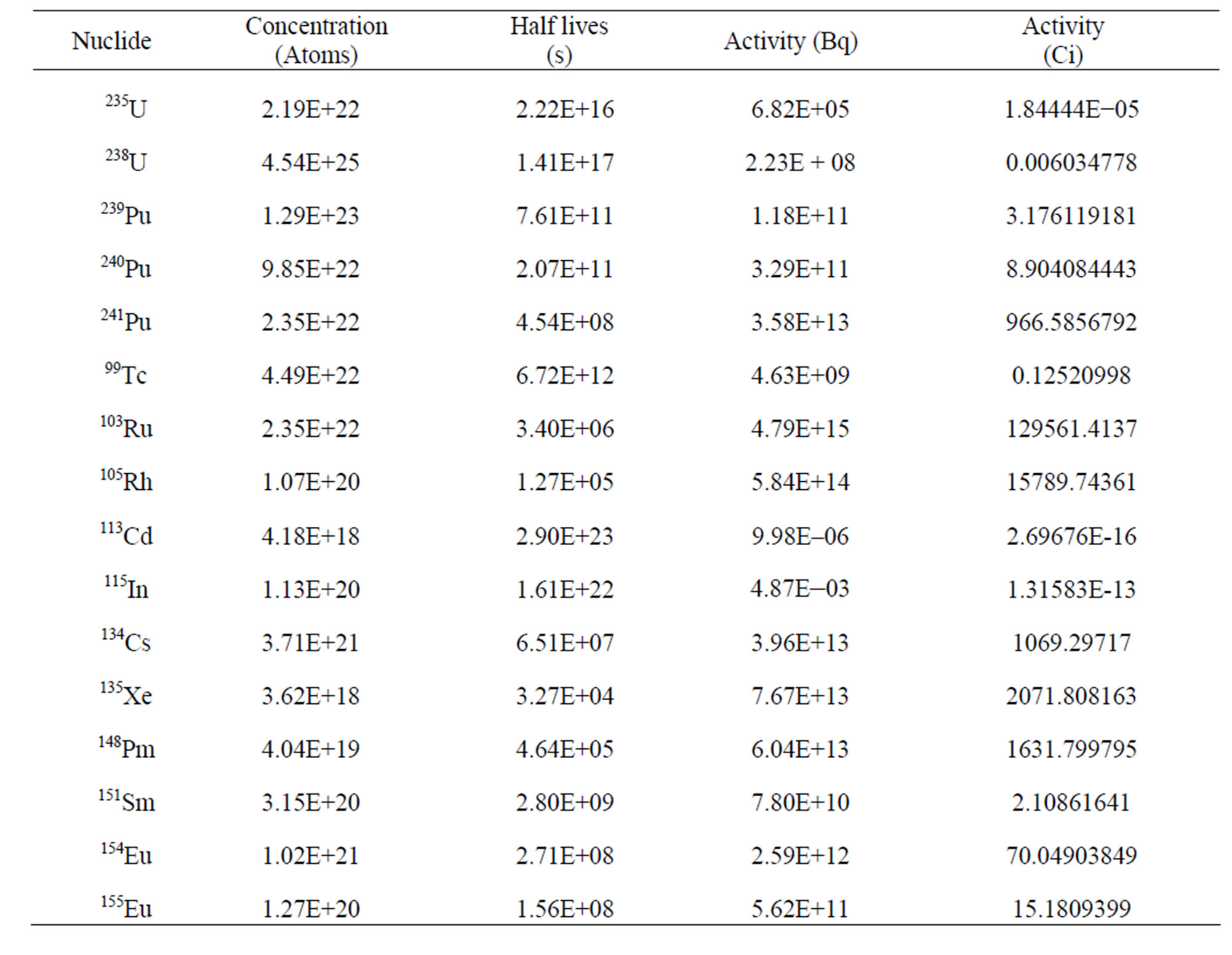
Table 1. The values of inventories and corresponding activities of important fission products and actinides for the UO2 lattice at 16,000 MWD/te.
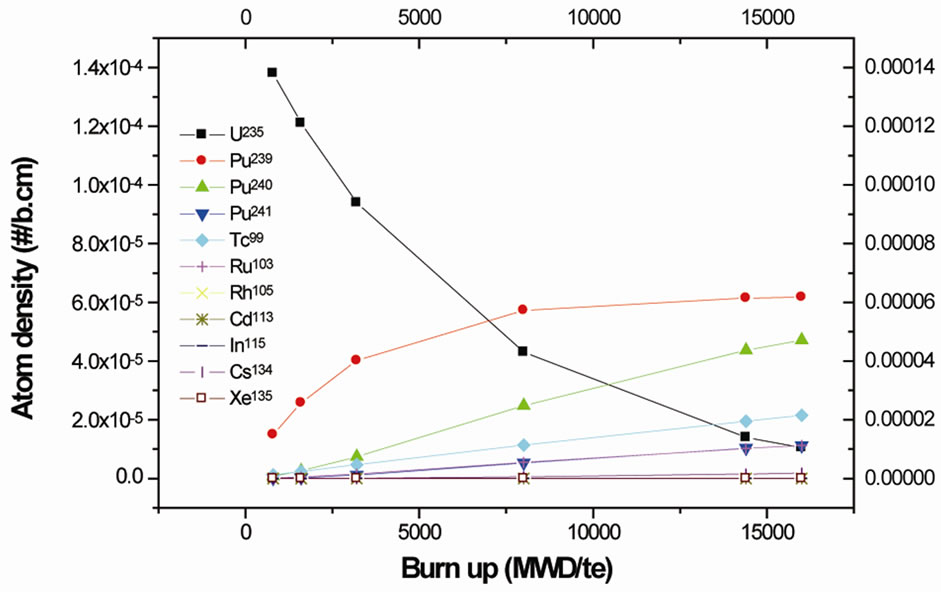
Figure 1. Atom density (#/b.cm) of important isotopes as a function of burn-up for the natural UO2 fuel
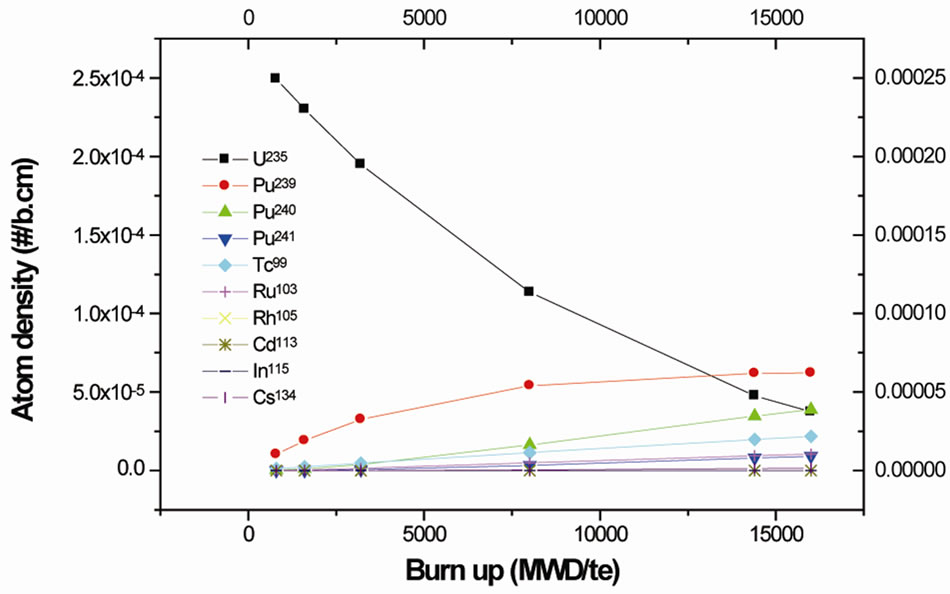
Figure 2. Atom density (#/b.cm) of important isotopes as a function of burn-up for the 1.2% enriched UO2 fuel.
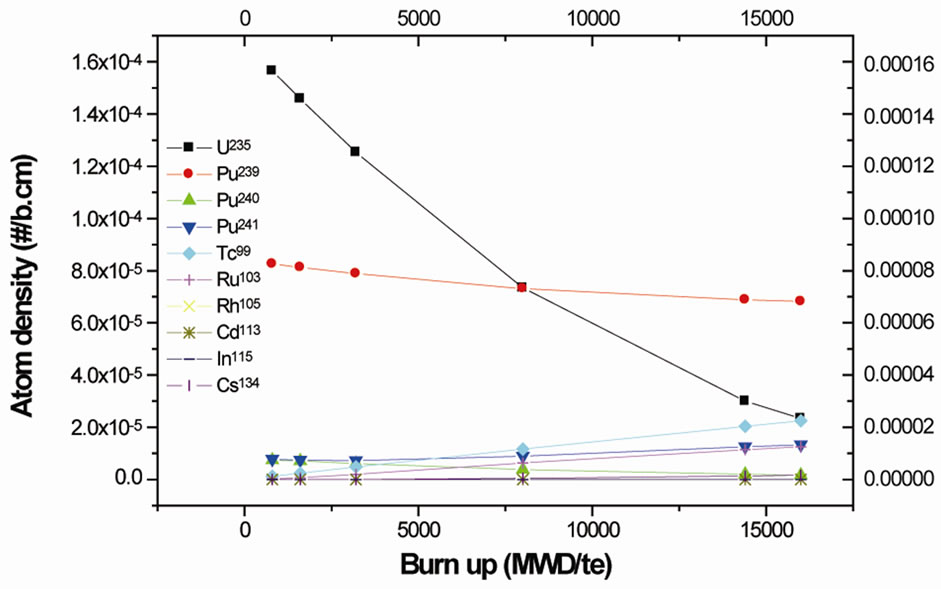
Figure 3. Atom density (#/b.cm) of important isotopes as a function of burn-up for the 0.45%PuO2 + natural UO2 fuel.
of important isotopes in the fuel bundle of the CANDU 600 MWe reactor. WIMS-D4 is originally developed at Atomic Energy Establishment, Winfrith, UK. This code solves the one dimensional neutron transport theory for research and power reactors. The code can use different types of libraries available for analysis. For the analysis presented in this paper, 69 groups neutron cross section library of UK origin is used. The library of 69 groups consists of, 14 fast above 9.118 KeV, 13 resonances between 4 eV - 9.118 KeV and 42 thermal groups below 4 eV. For the present work, the 69 groups in the data set library are collapsed to five-group cross section data set. The boundaries of the energy shift of these five groups are given in Table 2 of [13]. This five group option is used in the FEWGROUP card.
This code takes the cluster geometry of the cell with the cards ANNULUS, ARRAY, and RODSUB. Sizes in the annulus card are selected in such a way that the fuel to coolant volume ratio is conserved and each fuel pin centre lies very close to the mid-radius of its ANNULUS. This can be achieved by using the CRAIG option. The cell-averaged diffusion coefficients (D), absorption (∑a), fission cross sections (ν∑f), the infinite multiplication factor (kinf) and effective multiplication factor keff (if buckling is provided) can also be calculated by this code. For burn-up calculations, the code solves the burn-up equations for fuel and fission products for a given specific power and then calculates the isotopic compositions (#/b.cm) and concentrations (gm/cm) of important isotopes present in the reactor core.
For burn-up calculations, power C card is needed in the input of WIMSD4 file. A number of sets of POWER cards are used in the input with one set of cards specifying a burn-up step. The ratio of power in MWt to the amount of initial fuel in tones is required for these cards. For the CANDU 600 MWe case, this ratio is 25.06 MW/te. The computer code WIMSD4 has already been used by us to model the pin type and cluster type geometries [13,14].
4. Results and Discussions
These studies comprise of the calculations and comparison of the number densities (#/b.cm) and activities (Ci), as a function of fuel burn-up, of important nuclides for alternative fuel cycles of the CANDU 600 MWe PHWR. The number densities of important isotopes for natural UO2 fuel, 1.2 % enriched UO2 and 0.45% PuO2-UO2 fuel, are shown in Figures 1-3, respectively. These three figures show a decrease in the concentration of 235U with the burn-up that is due to the consumption of 235U. For the natural UO2 and 1.2% enriched UO2 fuel, there is an increase in the concentration of 239Pu and other actinides and fission products and there is smaller increase in the amount of 239Pu as compared to UO2 fuel and 0.45% PuO2+UO2 fuel. For 0.45% PuO2+UO2 fuel, there is a slow decrease in the concentration of 239Pu, due to the239Pu already present in the core and second generation of 239Pu. Figures 1-3 show that the nuclides 235U, 239Pu, 240Pu, 241Pu, 99Tc, 135Xe, 103Ru, and 134Cs have large
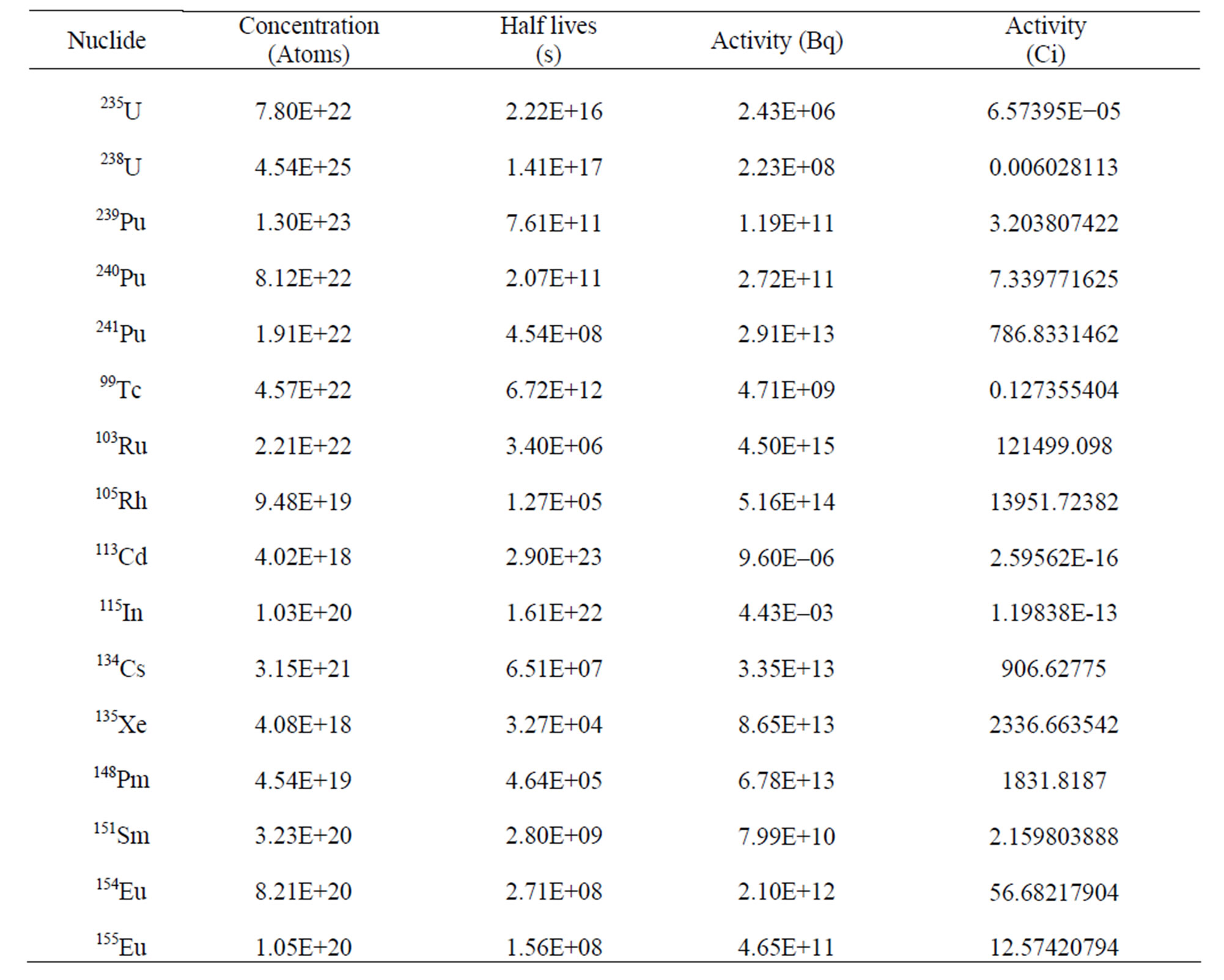
Table 2. The values of inventories and corresponding activities of important fission products and actinides for the 1.2% enriched UO2 lattice at 16,000 MWD/te.
concentration as compared to the other nuclides in the core. The activities are shown in Figures 4-6 for natural UO2 fuel, 1.2% enriched UO2 and 0.45%PuO2-UO2 fuel, respectively. From the Figures 4-6 it is seen that the nuclides 103Ru, 105Rh, 135Xe, 137Cs, 241Pu, 134Cs, 151Sm, 154Eu, 241Pu, 240Pu and 239Pu have more activity as compared to other nuclides in the reactor core. The Figures also show that the nuclides produced in the 1.2% enriched UO2 fuel have the lower activities as compared to the other two fuel cycles and vice versa for the 0.45%PuO2+UO2 fuel. This means that from the environmental point of view, 1.2% enriched UO2 fuel is more useful in CANDU reactors as compared to natural uranium fuel and the fuel in which Plutonium is mixed with natural uranium. Plutonium mixed with natural uranium has more contribution of these nuclides and hence not a better choice from environmental point of view but it can be used to extend the fuel burn-up and to burn the large stocks of civil and military plutonium [10]. Moreover, there is a general trend to reduce the plutonium because of the serious public and political concerns in the world about the misuse of plutonium or accidental release into the environment [10]. Thorium mixed with UO2 or PuO2 is a better fuel composition from environmental and proliferation perspectives but it can be beneficial for a country that has lot of thorium reserves, like India.
The sum of the activities (in Curie) of important isotopes as a function of burn-up for natural UO2 fuel, 1.2% enriched UO2 and 0.45%PuO2-UO2 fuel, is shown in Figure 7. In the three cases, there is a linear increase in activity with the burn-up and the 1.2% enriched UO2 fuel has the lowest activity as compared to other two fuel cycles and vice versa for the 0.45%PuO2+UO2 fuel. Hence, from environmental aspect, 1.2% enriched UO2 fuel is more useful in CANDU reactors as compared to natural uranium fuel and the fuel in which Plutonium is mixed with natural uranium. Consequently, again, from environmental point of view plutonium mixed in natural UO2 is not a better choice but it can be used to extend the fuel burn-up and to destroy the huge quantity of plutonium in the world. Thorium mixed with UO2 or PuO2 is a better fuel composition from environmental and proliferation perspectives.
The inventory and activity (in Becquerel and in Curie) of important isotopes calculated at 16,000 MWD/te for the three fuel cycles i.e. natural UO2, 1.2% enriched UO2

Figure 4. Activities (Ci) of important isotopes as a function of burn-up for the natural UO2 fuel.

Figure 5. Activities (Ci) of important isotopes as a function of burn-up for the 1.2% enriched UO2 fuel.
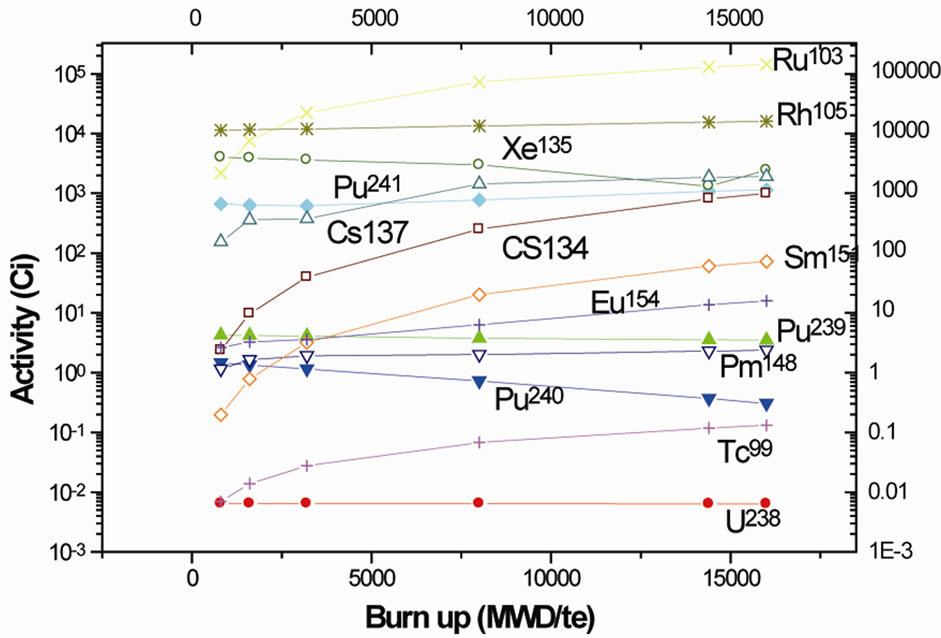
Figure 6. Activities (Ci) of important isotopes as a function of burn-up for the 0.45%PuO2 + natural UO2 fuel.
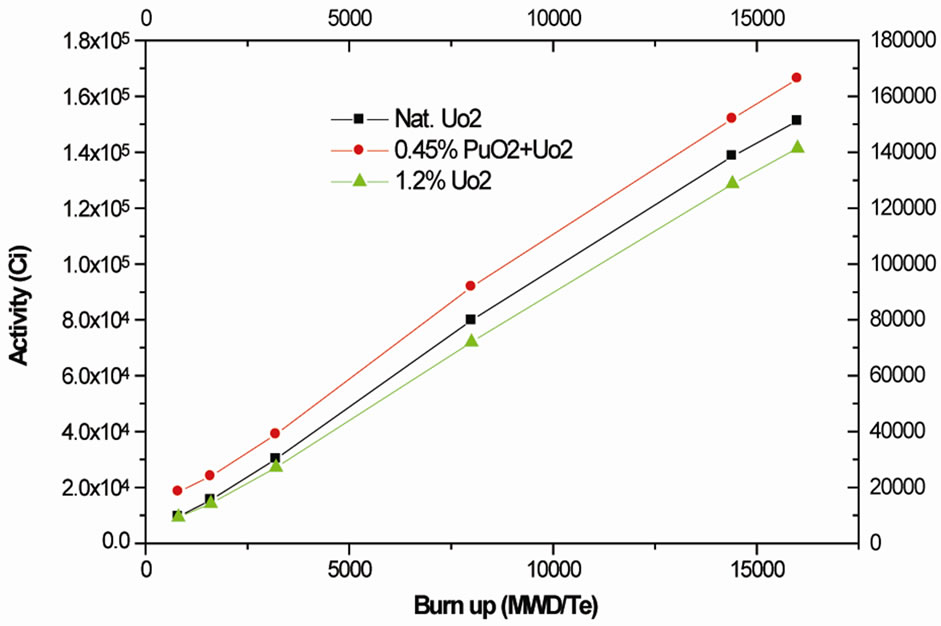
Figure 7. Total activities (Ci) of important isotopes as a function of burn-up for the natural UO2, 1.2% enriched UO2, and 0.45%PuO2 + natural UO2 fuel.
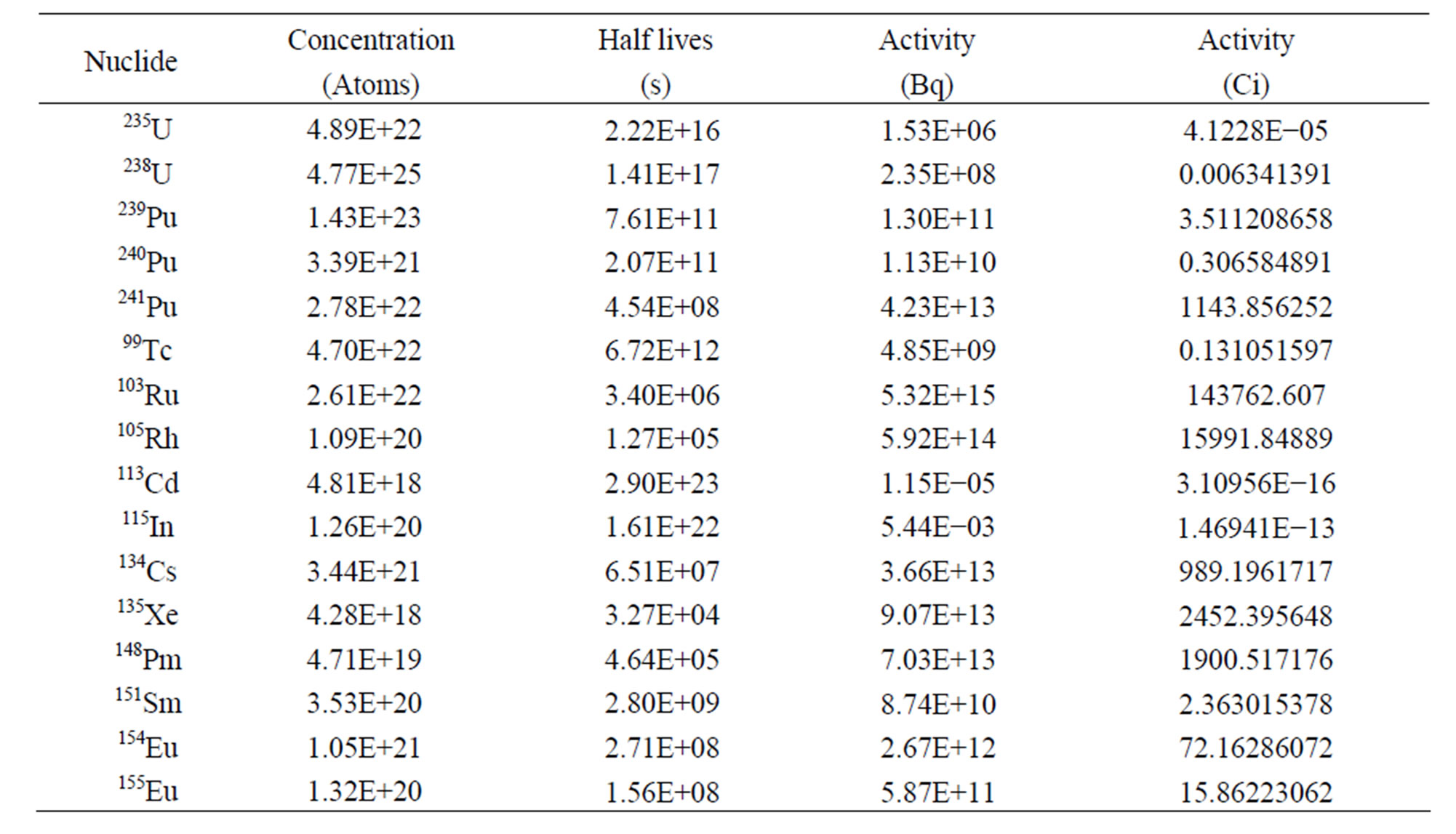
Table 3. The values of inventories and activities of fission products and actinides for the 0.45%PuO2+UO2 lattice at 16,000 MWD/te.
and 0.45%PuO2+UO2 are shown in Tables 1, 2 and 3, respectively. From these tables, the major contribution to the total activity is from the nuclides 241Pu, 103Ru, 105Rh,134Cs, 135Xe and 148Pm. In natural UO2 fuel and in 0.45%PuO2+UO2 fuel these isotopes have more contribution and hence lead to more activity as compared to 1.2% enriched UO2 fuel that has least activity.
In case of 1.2% enriched UO2 fuel, more neutrons are absorbed in 235U as compared to natural UO2 and 0.45% PuO2+UO2 fuel. The reason for more activity in UO2 and 0.45%PuO2 is the more fission in 239Pu as compared to fission in 235U.
5. Conclusions
The results presented in the present paper comprise of calculations and comparison of the effect of slightly enriched uranium i.e. 1.2% enriched UO2 and 0.45%PuO2+ UO2 with the activities of important isotopes during the fuel burn-up. The results are presented in the form of figures. The conclusion of three fuel cycles considered in the present work is; the activity of 1.2% enriched UO2 fuel is much smaller as compared to natural UO2 fuel and plutonium mixed in UO2 fuel. Secondly, the slightly enriched UO2 fuel will make radioactive waste management more effective and have less environmental impact, compared with other two fuel cycles.
6. References
[1] Z. Yasin, “Burn-up Extension with Slightly Enriched Uranium and Plutonium in CANDU Reactors,” Nuclear Engineering and Design, Vol. 240, No. 10, 2010, pp. 2862-2865. doi:10.1016/j.nucengdes.2010.05.068
[2] Z. Yasin and M. I. Shahzad, “From Conventional Nuclear Power Reactors to Accelerator-Driven Systems,” Annals of Nuclear Energy, Vol. 37, No. 2, 2010, pp. 87-92. doi:10.1016/j.anucene.2009.11.003
[3] C. Rubbia, et al., “Conceptual Design of a Fast Neutron Operated High Power Energy Amplifier,” CERN/AT/95- 44 (ET), 29 September 1995.
[4] Z. Xu, “Design Strategies for Optimizing High Burn-up Fuel in Pressurized Water Reactors,” Ph.D Thesis, Massachusetts Institute of Technology, Cambridge, 2000.
[5] D. F. Torgerson, P. G. Boczar and A. R. Dastur, “CANDU Fuel Cycle Flexibility,” 9th Pacific Basin Nuclear Conference, Sydney, 1-4 May 1994.
[6] OECD/NEA, “The Economics of the Nuclear Fuel Cycle,” OECD/NEA Report, OECD/NEA, Issy-Les-Moulineaux, 1994.
[7] B. Pellaud, “Proliferation Aspects of Plutonium Recycling,” Comptes Rendus Physique, Vol. 3, No. 7, 2002, pp. 1067-1079. doi:10.1016/S1631-0705(02)01364-6
[8] P. Jee-Won, “A Subchannel Analysis of DUPIC Fuel Bundle for the CANDU Reactor,” Annals of Nuclear Energy, Vol. 26, No. 1, 1999, pp. 29-46. doi:10.1016/S0306-4549(98)00028-0
[9] S. Sahin, et al., “Power Flattening in the Fuel Bundle of a CANDU Reactor,” Nuclear Engineering and Design, Vol. 232, No. 1, 2004, pp. 07-11
[10] S. Sahin, et al., “An Assessment of Thorium and Spent LWR-Fuel Utilization Potential in CANDU Reactors,” Energy Conversion and Management, Vol. 47, No. 13-14, 2006, pp. 1661-1675. doi:10.1016/j.enconman.2005.10.013
[11] H. P. Gupta, et al., “Advanced Fuel Cycles for Use in PHWRs,” Journal of Nuclear Materials, Vol. 383, No. 1-2, 2008, pp. 54-62.
[12] M. J. Halsall, “Summary of WIMSD4 Input Options,” AEEW-M 1327, Dorchester, 1980.
[13] Z. Yasin, “Calculation of Fuel Burn-up and Radioactive Inventory in a CANDU Reactor Using WIMSD4 Code,” Annals of Nuclear Energy, Vol. 37, No. 1, 2010, pp. 87-92. doi:10.1016/j.anucene.2009.11.003
[14] Z. Yasin, “Comparative Study of Fuel Burn-up and Radioactive Inventory for Proliferation and Proliferation Resistance Fuel Lattices,” Annals of Nuclear Energy, Vol. 36, No. 9, 2009, pp. 1635-1638. doi:10.1016/j.anucene.2009.08.004

